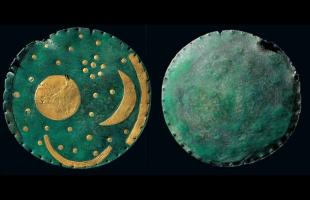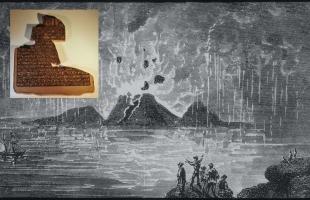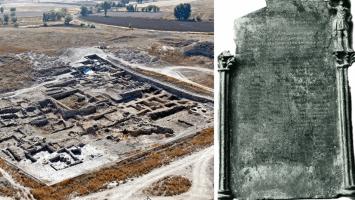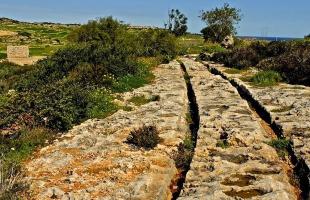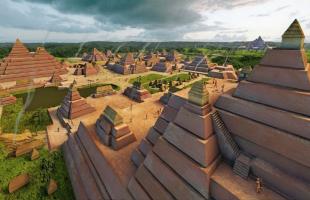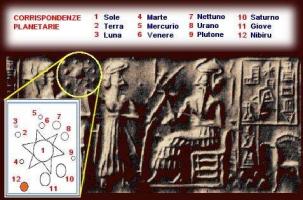The bronze ships and the votive items of the Nuragic civilization

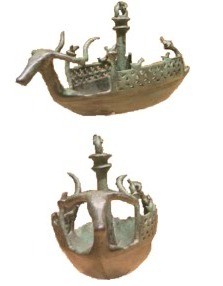
The study of nacelles has almost never been separated from the more general study of the production of Sardinian figurative bronzes. This has been happening since the time of Lamarmora who, in 1840, classified them as "votive objects of oriental origin with a dove at the top of the tree, an animal dedicated to Venus".
As according to Tacitus, Isis was worshiped through the symbol of the little boat (due to its moon-shaped shape), Lamarmora advances the hypothesis that the little boats were dedicated to Astarte, who combined the characteristics of Isis and Artemis.
In 1884 Crespi rejected the opinion of those who saw these bronzes as lamps. This is because "the function would be impeded by the shape, unsuitable to accommodate a possible wick, and because the sides of the nacelles are sometimes perforated". However, the stern of many spacecraft designs a sort of spout, similar to what is observed on many oil lamps, and the perforations are always above the edge of the hull, thus allowing perfect containment of any liquid.
The protome, common to all ancient ships, represents for Crespi a "tutelary deity, under whose protection the ships were placed. Other times it is considered an insignia, to recall some particular characteristic or from which the ship took its name ship. Thus, for example, the deer's head can signify lightness and speed". The protome was destined to strike as a rostrum. For Crespi, the small boats were models of real ships, and in his opinion they could be hung, as votive offerings, in the domestic environment of the house for the escaped adventure or for the happy arrival in the new land.
In 1884 Pais focuses on the custom, common among ancient populations, of decorating the bow and stern of ships with an animal image: goose, swan, lion, horse. However, never of bull, deer, antelope, as instead happens on the Sardinian ships.
Returning to Crespi, who wanted the characteristics of agility and speed of the vessel, Pais wonders what meaning the predominant figure of the bull can take on in this sense. He notes how in ancient times the horse was little known on the island, and how there are very few bronzes depicting men on horseback, compared to those which instead show men on the back of the bull. Thus, on the other hand, it is also true that the Punic coins minted in Carthage have the horse imprinted while the Sardinian coins at the same time show the bull. The bull, therefore, would replace the horse in the bow decoration, an animal that characterizes the protome of the Phoenician hippos.
Sardinia
Actually could also have been ex-votos from Sardinian soldiers who served overseas powers. In 1884 the so-called nacelle from the Tomb of the Duce was already widely known, which first offered the possibility of a reliable dating by Lilliu, given that the Etruscan context of discovery placed it with reasonable certainty around the second half of the 7th century BC, at the same time attracting the attention of a large number of scholars on a national level.
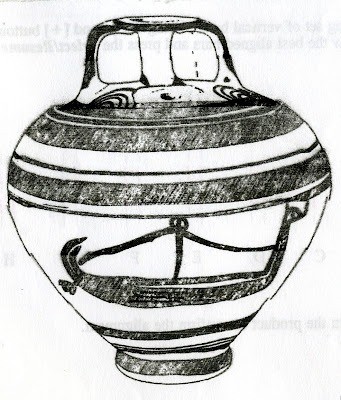
The idea that the Nuragic boats were an object somehow linked to funerary and votive use, accredited by the places and context of the discoveries (tombs or temples), as well as by the immediate comparison with the small boats of Eastern and Egyptian antiquity, it is also shared by Taramelli in 1913.
Zervos considers the nacelles no differently as symbolic-funerary boats but in 1954 he recognizes in the nacelles from Oliena and Vetulonia, both with keeled hulls, a possible model of real boats. In particular, he distinguishes boats with an elliptical-convex hull, for votive and funerary use, from those with a trapezoidal section hull, models of real boats.
In 1962 Lilliu, detecting certain traces of an ancient restoration on the spacecraft coming from Aritzo, was the first to overturn many of these beliefs, reading the rough patch as incontrovertible proof of not only votive, but also daily, domestic use of these objects, in which he recognizes some lamps. He distinguishes between a long type explicitly compared to the Phoenician hippos and a short type similar to the golah. Supporting both the practical use, as a lamp, and the votive funerary use of the object, Lilliu sees in the Sardinian boats proof of the existence of a Nuragic coastal and high seas navy.
A second proof, this time from a literary source, should be sought in the well-known passage in which Strabo writes about acts of piracy repeatedly carried out on the coasts of Tuscany by mountaineers coming from Sardinia. This is not shared by the historian Meloni in 1975, who, reporting the passage in its entirety, notes that following these incursions it was decided by Rome to send military governors to Sardinia, and that therefore the narrated facts should be dated not to the Nuragic era, but rather around the year 6 AD, in the context of general insecurity that characterized the island under Augustus. In that era the Sardinians, having already assimilated the secrets of nautical art from the Carthaginians, and the technique of pirate assault from Sesto Pompeo, would have been perfectly capable of threatening the Tyrrhenian coasts, but it must be noted that they were Sardinians of the internal areas and this implies a link between the indigenous Sardinians and the sea, when many Sardinians were still embarked on various fleets such as that of Miseno.
The chronology of the ships is made to substantially agree with that of the other bronzes, starting in the 9th BC. Another scholar, Gras, returned to the subject in 1985, recognizing as comparable to the Sardinian type a ship painted on a vase from Skyros, datable to the Mycenaean III era. Thus, it would not be possible to exclude a backdating of the Sardinian sculptures to the 12th BC. The thesis is welcomed by Lilliu, who sees in the Skyros spacecraft the sign of the presence of a Sardinian navy already in the 12th BC and of Nuragic merchants who participated in the Mediterranean trades in all directions.
The idea of one or more Nuragic populations dedicated to the art of seafaring and naval carpentry, sailing the Mediterranean carrying out fruitful trades with other coastal peoples, however stimulating and fascinating, requires more careful examination and verification. Since the literary sources are silent, it seems that a contribution to the resolution of some of these questions can come from an examination of the nautical capabilities and functionality of the boats depicted in the ancient bronze sculptures, so as to be able to somehow evaluate whether and to what extent hulls of a similar shape to those presumably reproduced in the Sardinian bronzes were capable of undertaking maritime voyages and transport and, if so, in which geographical area.
In particular, we will try to verify the presence, on the Sardinian ships, of representations of equipment and instruments suitable for navigation, such as masts, sails, wheelhouses, oars, oarlocks, bridges, rostrums, also evaluating where possible the adequacy of the dimensions.
The chemical and metallographic analyzes of the Nuragic era artefacts have highlighted the non-homogeneity of the relationship between the components of the alloy, with the identification of specimens particularly rich in copper, and others with high percentages of lead and iron, as reported in 2005 by the scholar Depalmas on page. 168 of her work on the Nuragic ships. The percentages of tin remain stable at canonical values between 8 and 10%.
A problem that strictly affects attempts to determine metal deposits is the practice of remelting. The creation of a metal object can, in fact, be the result of the fusion of several metal elements of different origins, combined with the aim of recycling the metal through a new fusion, a very widespread practice attested by the numerous discoveries, carried out especially in storage rooms and workshops, of fragmentary materials accumulated for reuse.
We will call the set of structures that make up the body of a float the hull. The hull is divided into "underside" and "overhead", depending on whether one refers respectively to its immersed or emerged part. The hull can be closed by one or more decks, the outermost of which is called the deck deck. Various equipment is placed on this: masts, oarlocks, rigging, bollards, cabins, hatches.
The hull can take on various shapes established by the laws of hydrodynamics and by different navigation or loading needs. Circular-shaped hulls were in use among the ancient river civilizations of Mesopotamia. Elongated hulls are common to all ancient navies, from the Egyptian to the Etruscan and Phoenician. The construction techniques of a hull vary according to the materials used: they range from bundles of papyrus tied together, to rafts of overlapping planks up to structures with keel, ribs and beams.
The latter is the most perfect because it allows the creation of large hulls with excellent resistance and lightness characteristics. The so-called Phoenicians were favored by the availability of tall wood, essential for shipbuilding of this type. However, it should be noted that the first Phoenician boats were contemporary with the last Nuragic ones. The keel and rib structure is made up of a longitudinal element on which the ribs are placed, arranged transversely. The skeleton thus obtained, strengthened by joining the walls with ribs and bridges, is covered with planking, made up of thin wooden planks placed side by side and sometimes replaced by skins, mats or other materials, then made waterproof by sprinkling them with pitch or bitumen with the operation that it is called caulking.
Nuragic ships generally have an open hull, without a deck, and a sometimes flat bottom. The open hull is synonymous with ships no longer than 8 meters in length as the lack of transversal reinforcing elements would compromise, in larger structures, the necessary qualities of resistance to lateral, longitudinal and torsional stresses. Larger boats should show, even in the model, effective transverse reinforcing structures of which no example is offered on Sardinian nacelles outside of n° 47 of my book.
Most Sardinian spaceships have an elliptical-convex hull with a more or less flattened bottom. The simultaneous presence of convex shapes and flat bottoms poses some interpretative problems: a flat-bottomed boat cannot be built with the keel and rib technique, which normally gives rise to a convex main section with a strongly pronounced keel line; on the other hand, a hollow, ellipsoidal and rounded hull cannot be obtained with any other techniques other than the one just excluded.
- a) the hull of the nacelles, convex in the real boats of which they are the model, was deliberately flattened in order to better lay the object flat, to use it as a lamp;
- b) the hull of the spacecraft is a non-faithful reproduction of that of boats observed during navigation, when the keel (underside) is submerged and the emerged part (overhead) is the only one that appears clear to the eye.









